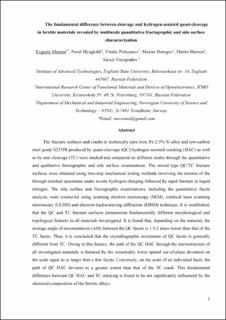| dc.contributor.author | Merson, Evgeniy | |
| dc.contributor.author | Myagkikh, Pavel | |
| dc.contributor.author | Poluyanov, Vitaliy | |
| dc.contributor.author | Dorogov, Maxim | |
| dc.contributor.author | Merson, Dmitry | |
| dc.contributor.author | Vinogradov, Alexey | |
| dc.date.accessioned | 2022-07-05T07:38:16Z | |
| dc.date.available | 2022-07-05T07:38:16Z | |
| dc.date.created | 2022-01-04T14:30:34Z | |
| dc.date.issued | 2021 | |
| dc.identifier.citation | Materials Science & Engineering: A. 2021, 824 . | en_US |
| dc.identifier.issn | 0921-5093 | |
| dc.identifier.uri | https://hdl.handle.net/11250/3002677 | |
| dc.description.abstract | The fracture surfaces and cracks in technically pure iron, Fe-2.5% Si alloy and low-carbon steel grade S235JR produced by quasi-cleavage (QC) hydrogen-assisted cracking (HAC) as well as by true cleavage (TC) were studied and compared on different scales through the quantitative and qualitative fractographic and side surface examinations. The mixed type QC/TC fracture surfaces were obtained using two-step mechanical testing methods involving the tension of the through-notched specimens under in-situ hydrogen charging followed by rapid fracture in liquid nitrogen. The side surface and fractographic examinations, including the quantitative facets analysis, were conducted using scanning electron microscopy (SEM), confocal laser scanning microscopy (CLSM) and electron-backscattering diffraction (EBSD) technique. It is established, that the QC and TC fracture surfaces demonstrate fundamentally different morphological and topological features in all materials investigated. It is found that, depending on the material, the average angle of misorientation (AM) between the QC facets is 1.5–2 times lower than that of the TC facets. Thus, it is concluded that the crystallographic orientation of QC facets is generally different from TC. Owing to this feature, the path of the QC HAC through the microstructure of all investigated materials is featured by the remarkably lower spatial out-of-plane deviation on the scale equal to or larger than a few facets. Conversely, on the scale of an individual facet, the path of QC HAC deviates to a greater extent than that of the TC crack. This fundamental difference between QC HAC and TC cracking is found to be not significantly influenced by the chemical composition of the ferritic alloys. | en_US |
| dc.language.iso | eng | en_US |
| dc.publisher | Elsevier | en_US |
| dc.rights | Attribution-NonCommercial-NoDerivatives 4.0 Internasjonal | * |
| dc.rights.uri | http://creativecommons.org/licenses/by-nc-nd/4.0/deed.no | * |
| dc.title | The fundamental difference between cleavage and hydrogen-assisted quasi-cleavage in ferritic materials revealed by multiscale quantitative fractographic and side surface characterization | en_US |
| dc.type | Peer reviewed | en_US |
| dc.type | Journal article | en_US |
| dc.description.version | acceptedVersion | en_US |
| dc.rights.holder | This is the authors' accepted manuscript to an article published by Elsevier. Locked until 30.7.2023 due to copyright restrictions. | en_US |
| dc.source.pagenumber | 14 | en_US |
| dc.source.volume | 824 | en_US |
| dc.source.journal | Materials Science & Engineering: A | en_US |
| dc.identifier.doi | 10.1016/j.msea.2021.141826 | |
| dc.identifier.cristin | 1974472 | |
| cristin.ispublished | true | |
| cristin.fulltext | postprint | |
| cristin.qualitycode | 2 | |

